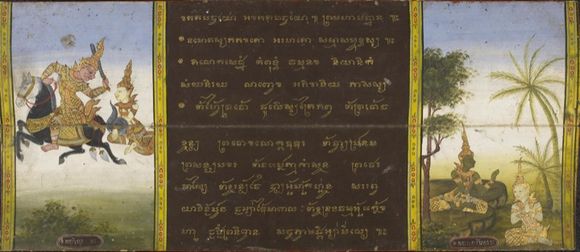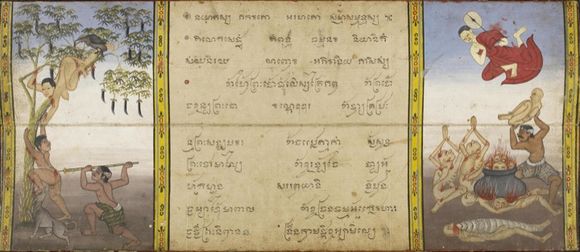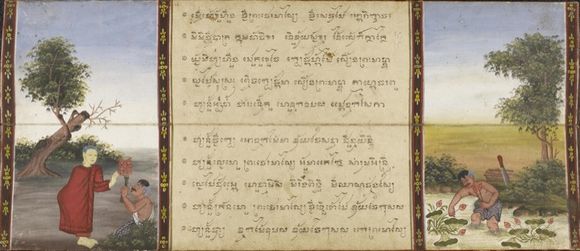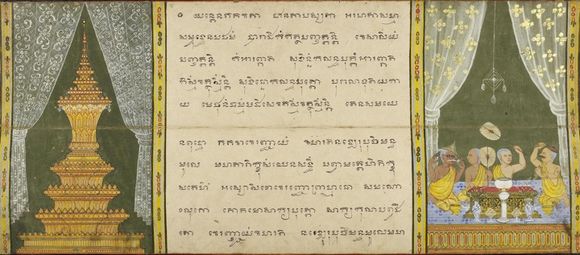The legend
of Phra Malai, a Buddhist monk of the Theravada tradition said to have attained
supernatural powers through his accumulated merit and meditation, is the main
text in a nineteenth-century Thai folding book (samut khoi) held in the Thai, Lao and Cambodian Collections (Or.
16101). Phra Malai
figures prominently in Thai art, religious
treatises, and rituals associated with the afterlife,
and the story is one of the most popular subjects
of nineteenth-century illustrated Thai manuscripts. The earliest surviving examples of
Phra Malai manuscripts date back to the late eighteenth century, although it is
assumed that the story is much older, being based on a Pali text. The legend also has some parallels with
the Ksitigarbha Sutra.
The Thai text in this
manuscript is combined with extracts in Pali from the
Abhidhammapitaka, Vinayapitaka, Suttantapitaka, Sahassanaya,
and illustrations from the Last Ten Birth Tales of the Buddha (Thai thotsachat).
Altogether, the manuscript has 95 folios with illustrations on 17 folios. It
was very common to combine these or similar texts in one manuscript, with Phra Malai
forming the main part. These texts are written in
Khom script, a variant of Khmer script often used in Central Thai religious
manuscripts. Although Khom script, which was regarded as sacred, was normally
used for texts in Pali, in the Thai manuscript tradition, the story of Phra Malai
is always presented in Thai. Because Khmer script was not designed for a tonal language like Thai,
tone markers and certain vowels that do not exist in Khmer script have been
adopted in Khom script to support the proper Thai pronunciation and intonation.

Vidura and Vessantara Jatakas (Or 16101, folio 6)

Most of the text is in black ink on
paper made from the bark of the khoi tree (streblus asper). However, the text
accompanying the illustrations of the Last Ten Birth Tales is written in gold
ink on blackened khoi paper, emphasizing the importance of these Jatakas
symbolising the ten virtues of the Buddha. Gold ink, as well lavish
gilt and lacquered covers, added value and prestige to the manuscript, which
was commissioned on occasion of a funeral service. The commission
and production of funeral presentation volumes was regarded as a way of earning merit on behalf of the
deceased.
Other miniature paintings depict the
Buddha in meditation, scenes from the life of
Phra Malai, as well as genre scenes of lay people. According to a colophon in
Thai script on the first folio, the manuscript is dated 2437 BE (AD 1894).

Phra Malai visiting hell (Or 16101, folio 8)

During his visits to hell (naraka),
Phra Malai is said to bestow mercy on the creatures suffering there. They
implore him to warn their relatives on earth of the horrors of hell and how
they can escape it through making merit on behalf of the
deceased, meditation and by following Buddhist precepts.
Although the subject of hell is mentioned in the Pali canon
(for example, in the Nimi Jataka, the Lohakumbhi Jataka, the Samkicca
Jataka, the Devaduta Sutta, the Balapanditta Sutta, the Peta-vatthu etc.) the legend of Phra
Malai is thought to have contributed significantly to the idea of hell in Thai society.
Back in the human realm, the monk receives an
offering of eight lotus flowers from a poor woodcutter, which he eventually
offers at the Chulamani Chedi, a heavenly stupa believed to contain a
relic of the Buddha. In Tavatimsa heaven, Phra Malai converses with the god
Indra and the Buddha-to-come, Metteyya, who reveals to the monk insights about
the future of mankind.

Lotus offering scene, Or 16101, folio
28

Through recitations of Phra Malai the karmic effects
of human actions were taught to the faithful at funerals and other merit-making
occasions. Following Buddhist precepts, obtaining
merit, and attending performances of the
Vessantara Jataka all counted as virtues that increased the chances of a
favourable rebirth, or Nirvana in the end.
Illustrated
folding books were produced for a range of different purposes in Thai Buddhist
monasteries and at royal and local courts. They served as handbooks and
chanting manuals for Buddhist monks and novices. Producing folding books or
sponsoring them was regarded as especially meritorious. They often, therefore,
functioned as presentation volumes in honor of the deceased. It comes as no
surprise that this manuscript contains an illustration of a lavishly decorated
coffin attended by two Buddhist monks who are trying to fend off two ‘fake’
monks.

Funeral scene (Or
16101, folio 92)

Traditionally, Thai monks reciting
the legend of Phra Malai would embellish and dramatise their performances,
contrary to their strict behavioural rules. By the end of the nineteenth
century, monks were officially banned from such performances. As a result, retired
or ‘fake’ monks often delivered the popular performances, unconstrained by the
rules of the Sangha.
A full text digital copy of Or 16101 can be viewed online at British Library Digitised Manuscripts.

Lacquered front cover with gilt flower ornaments (Or
16101)

Further reading
There is an
excellent translation from Thai into English of the entire legend of Phra Malai
by Bonnie Pacala Brereton, which is included in her book Thai Tellings of
Phra Malai – texts and rituals concerning a Buddhist Saint. Tempe, Arizona: Arizona
State University, 1995
Chawalit, Maenmas (ed.): Samut khoi. Bangkok: Khrongkan
suepsan moradok watthanatham Thai, 1999
Ginsburg,
Henry: Thai art and culture: historic manuscripts from Western Collections.
London: British Library, 2000
Ginsburg,
Henry: Thai manuscript painting. London: British Library, 1989
Igunma,
Jana: ʻAksoon Khoom - Khmer heritage in Thai and Lao manuscript cultures.ʼ
In: Tai Culture Vol. 23. Berlin : SEACOM, 2013
Igunma, Jana: ʻPhra Malai - A Buddhist Saint’s Journeys to
Heaven and Hell.ʼ
Peltier, Anatole: ʻIconographie de la
légende de Braḥ Mālay.ʼ BEFEO, Tome LXXI (1982), pp. 63-76
Wenk, Klaus: Thailändische Miniaturmalererien nach einer
Handschrift der Indischen Kunstabteilung der Staatlichen Museen Berlin.
Wiesbaden: Franz Steiner, 1965
Zwalf, W. (ed.): Buddhism: art and faith. London:
British Museum Publications, 1985
Jana Igunma, Asian and African Studies
